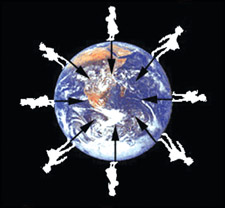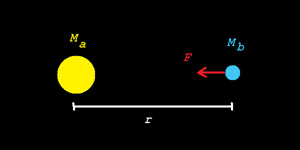Gravity:
The force that keeps us from falling off
 Have
you ever wondered why things fall down and not go up? Have you also
wondered why people Have
you ever wondered why things fall down and not go up? Have you also
wondered why people on the Earth don't fall off?
on the Earth don't fall off?
If you have heard of Sir Isaac Newton, you would have probably heard
the story about an apple falling almost on his head, causing him to
think of this very same idea! Every object in the Universe attracts
other objects with a force that is proportional to the masses of the
objects and inversely (in reverse) proportional to the squared distance
between objects.
Since the Earth is massive, it attracts us (no matter where we stand)
with a force strong enough to keep us from falling off. We call this
force gravity.
We can give a definition to gravity as follows; gravity is an
attractive force between any two objects in the Universe. The force attracting any two bodies is proportional to the
product of their masses and is inversely proportional to the squared
distance between them.
the Universe. The force attracting any two bodies is proportional to the
product of their masses and is inversely proportional to the squared
distance between them.
The attractive force of gravity acts between the centres of the two
objects. In the case of people standing on the Earth's surface, the
effect of gravity is to attract us towards the centre of the Earth.
As a result, no matter where you stand on the Earth, you do not fall
off. Gravity is also the reason why the Moon (and satellites) orbits the
Earth and why we orbit the Sun.
Then, why does'nt the Moon crash onto the Earth? In fact, the Moon is
constantly falling towards Earth; it is just that it keeps missing. With
an initial motion along the path of the orbit, the Moon can continually
fall towards Earth without ever reaching it.
In less than half a century, we have learned so much about the force
of gravity, the Earth, and the Universe we live in.
We have gone from a time when the idea of space travel was just that,
an idea, to the present, when man has landed on the Moon and Rovers have
explored Mars.
It is interesting to think about some of the predictions that were
made in the past, and to compare those predictions with reality. For
example, in the 19th century, Jules Verne wrote a novel called Around
the Moon.
He thought that a traveller flying in space would not experience the
pull of gravity! Little did he know his prediction, which was once only
fiction, will become fact! In space, everything becomes weightless!
Ever since that book was published, the image of astronauts floating
effortlessly in their space ships has inspired many people.
Do the creative artists of the present really have the ability to
foretell the future?
Whether or not they do, it makes science fiction all the more
interesting when you think that perhaps the imaginary technology
described in these novels may one day become real. From fiction to fact,
humankind's control over the force of gravity has the potential to
revolutionise our world.
****

The standard formula for Newton's Law
of Gravity is:
Gravitational force = (G m1 m2)
Where G is the gravitational constant, m1 and m2
are the masses of the two objects for which you are calculating the
force, and d is the distance between the centres of gravity of
the two masses.
****
Experiment - Spinning ball
What you need
* A small rubber ball
* Flat tabletop surface
* Medium-sized jam bottle or a condensed milk can with a wide mouth

What to do:
Now see if you can lift the ball up from the tabletop without
touching the ball or tipping over the jar. Can you do it?
Steps:
1. Place the ball on top of the table.
2. Place the jar over the ball so that the ball is inside the mouth of
the jar.
3. Start spinning the jar around in a circular motion (keeping it on the
table).
4. When the ball starts spinning inside the jar, lift it from the
tabletop.
5. The ball too will be lifted along with the jar from the table and it
will continue to spin inside the jar until it loses its speed.
This works because the ball spinning inside the jar is trying to
escape, but the jar itself forces the ball to stay inside the wall of
the jar. Due to the force of the spin or speed, the ball will continue
to spin until it loses its speed, gravity will pull it back to Earth,
and the ball will fall from the jar.
Compiled by Janani Amarasekara |
